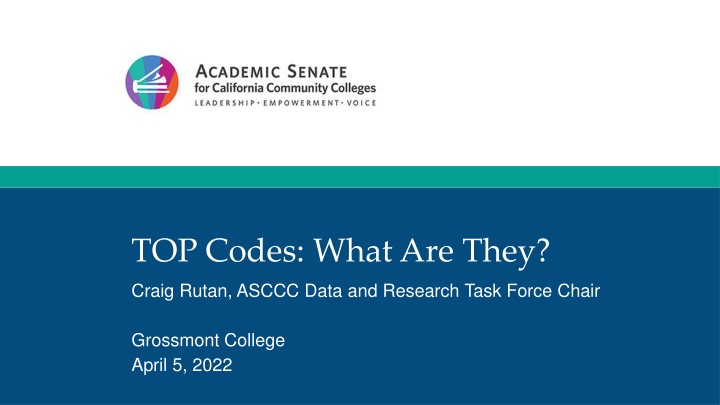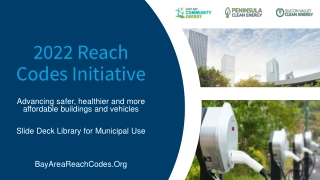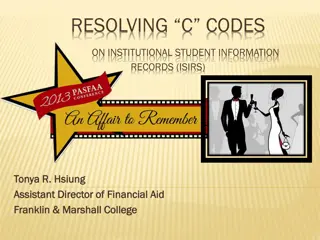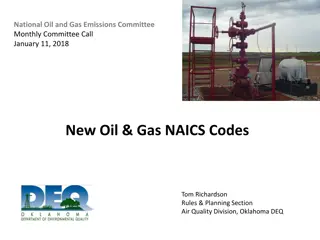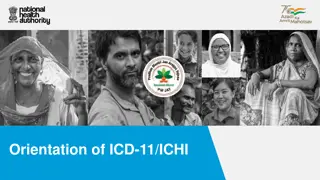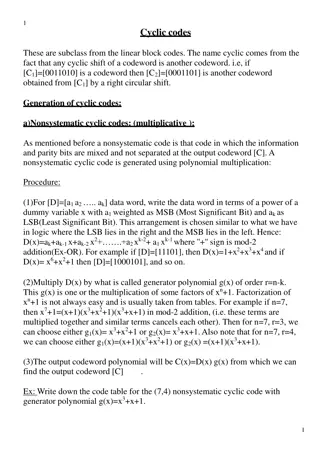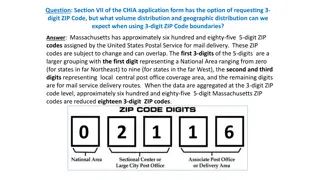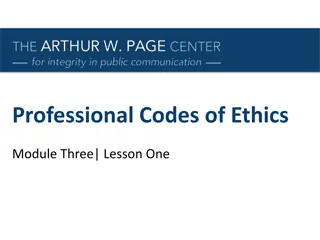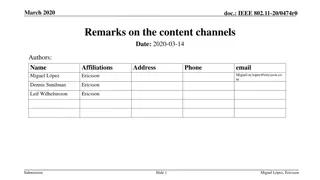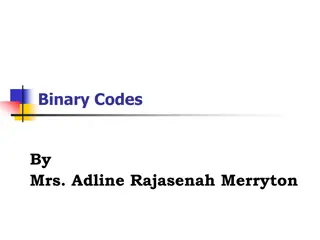Overview of TOP Codes: Categorizing Programs and Courses effectively
The purpose, history, and usage of TOP codes for categorizing programs and courses in educational institutions. Learn how TOP codes impact student success metrics, data reporting systems, and funding allocation processes.
Uploaded on Apr 09, 2025 | 0 Views
Download Presentation

Please find below an Image/Link to download the presentation.
The content on the website is provided AS IS for your information and personal use only. It may not be sold, licensed, or shared on other websites without obtaining consent from the author.If you encounter any issues during the download, it is possible that the publisher has removed the file from their server.
You are allowed to download the files provided on this website for personal or commercial use, subject to the condition that they are used lawfully. All files are the property of their respective owners.
The content on the website is provided AS IS for your information and personal use only. It may not be sold, licensed, or shared on other websites without obtaining consent from the author.
E N D
Presentation Transcript
TOP Codes: What Are They? Craig Rutan, ASCCC Data and Research Task Force Chair Grossmont College April 5, 2022
Overview Overview of TOP Codes CIP Codes Relationship of TOP and CIP Codes Assigning Courses to Disciplines Ethnic Studies 2
Purpose and History of TOP Codes Taxonomy of Program (TOP) codes categorize programs and courses. The Taxonomy of Programs was first published in 1979 by the Chancellor s Office. It is a system of numerical codes used at the state level to collect and report information on programs and courses, in different colleges throughout the state, that have similar outcomes. 1983 * added to identify vocational (CTE) programs. The most recent edition of the Taxonomy of Programs can be found here. 4
Why do we care about TOP codes? TOP codes are used as a proxy for programs, which impacts the Student Success Metrics, Data Mart, Salary Surfer, LaunchBoard, and any effort to compare outcomes across the state. TOP codes are assigned to every course and are often used to determine whether those courses should be included in various metrics. 5
TOP Code Usage Course Identification Program Identification Facilities, Budgets, Faculty, Outcome Reports Funding Apportionment Financial Aid Veterans Grants (Perkins) 6
TOP Code Usage The TOP was designed to aggregate information about programs. However, a TOP code must also be assigned to every course in our system. Although the TOP does not contain as many specific choices as would a system designed for courses, each course should be given the TOP code that comes closest to describing the course content. 7
TOP Code Structure Two, Four, and Six *01 *0109 *0109.10 Landscape *0109.20 Floriculture *0109.30 Nursery Agriculture Horticulture 8
TOP Code Structure There are state purposes for which only the first two digits of the Taxonomy, the most general level of classification, are used. For example: In reports on staffing, the teaching assignment of each classroom faculty member is characterized by the two-digit TOP discipline of most of the courses he or she teaches. In budget reports, spending on instructional programs is broken down by two-digit TOP discipline. In facilities planning, assignable square feet for laboratories varies according to the TOP discipline. 9
Selecting a TOP Code 01 Agriculture and Natural Resources 07 Information Technology 13 Family and Consumer Sciences 19 Physical Sciences 02 Architecture and Environmental Design 08 Education 14 Law 20 Psychology 03 Environmental Sciences and Technologies 09 Engineering and Industrial Technologies 15 Humanities (Letters) 21 Public and Protective Services 04 Biological Sciences 10 Fine and Applied Arts 16 Library Science 22 Social Sciences 05 Business and Management 11 Foreign Language 17 Mathematics 30 Commercial Services 06 Media and Communications 12 Health 18 Military Studies 49 Interdisciplinary Studies 10
Selecting a TOP Code Let s say that we want to select a TOP Code for Global Trade Operations Start looking in 05 Business and Management 11
Selecting a TOP Code What if there isn t a code that makes sense? Since the TOP Code manual is not updated regularly, it is likely that emerging fields will not have a TOP Code. One option would be to search for similar programs in COCI and use the same TOP code as other colleges If nothing really seems to work, each of the two digit TOP codes has an Other category. 12
CIP Codes 13
CIP Codes: What are they? Classification of Instructional Program (CIP) codes are the federal standard for postsecondary instructional program classification. All other postsecondary institutions in the U.S. use CIP codes for coding of instructional programs. These codes are used for financial aid, veterans programs, gainful employment reporting, and accreditation. Example: 50 Visual and Performing Arts 50.04 Design and Applied Arts 50.0402 Commercial and Advertising Art 14
CIP Codes vs. TOP Codes CIP is often more specific than TOP: 47 two-digit series (thousands of codes). CIP has strict organizational structure: programs are coded using 6- digit codes (always!) Not all CIP codes are applicable for community colleges: some describe instruction for 4-year and above. 15
Alignment between TOP and CIP The Chancellor s Office has published a TOP to CIP crosswalk that was updated in 2020 through the work of the Code Alignment Project. Because the TOP codes are not as detailed as the CIP codes, there could be more than one CIP code suggested for a single TOP code. The most current version of the crosswalk can be found here. 16
Do my programs have CIP codes? Every program we offer must have a CIP code for students to be eligible for federal financial aid, for federal data reporting, and as a requirement of accreditation. While you may have been asked for input on TOP codes, many faculty were unaware that their program even had a CIP code. At many colleges, the CIP code was selected by the financial aid office and may not align with the code that the discipline faculty would have selected. 17
SAM Codes 18
SAM Codes Student Accountability Model (SAM) Codes are used to indicate the degree to which a course is occupational (CTE), and to assist in identifying course sequence in CTE programs. 19
SAM Codes (CB09) *(A) Apprenticeship (offered to apprentices only) *(B) Advanced Occupational A B course is offered in one specific occupational area only and clearly labels its taker as a major in this area. The course may be a capstone course that is taken as the last requirement for a career technical education program. *(C) Clearly Occupational (but not advanced) Courses will generally be taken by students in the middle stages of their programs and should be of difficulty level sufficient to detract drop-ins. *(D) Possibly Occupational D courses are those taken by students in the beginning stages of their occupational programs. The D priority can also be used for service (or survey) courses for other occupational Programs. (E) Non-Occupational These courses are non-occupational. 20
SAM Code Usage Accreditation reports DataMart reports Student Success Metrics Educational Master Plan Goals Progress on Measurable Objectives Gainful Employment Program Disclosures Perkins Core Indicator Reports (VTEA) President's Load Study reports - used for Hiring Priorities Determining program eligibility for access to CTE grant funding Degree Audit program 21
Minimum Qualification In order to teach courses, faculty must meet the MQs of the disciplines to which those courses are assigned. A district may hire a person who possesses qualifications different from, but equivalent to, those listed on the disciplines list, according to criteria and procedures agreed upon by the governing board and the academic senate (Title 5 53430). MQs for disciplines are found in the Disciplines List. 24
What is a discipline? A discipline is defined as a grouping of courses that share common academic or vocational preparation, which are typically defined by a degree or degrees (MFA, MA, BA, MS, etc.), or specific professional preparation. Not the same as local departments or subject areas Defined in the Minimum Qualifications document maintained by the California Community Colleges Board of Governors Example: Local Department or Subject Name: Child and Family Studies Official Discipline: Early Childhood Education Discipline Definition in CA Education Code 87357 Not the same as or related to TOP codes and names, or FSAs. 25
Who assigns courses to disciplines? Identified in Title 5 section 53200 as an academic and professional matter within curriculum: (c) Academic and professional matters means the following policy implementation matters: (1) curriculum, including establishing prerequisites and placing courses within disciplines; development and Determines the minimum qualifications necessary to teach a course; Determined by local process, but Senate has regulatory authority; Local process should rely on discipline faculty expertise with review and oversight by local Curriculum Committee, Senate, or both; Curriculum Committee often charged with overseeing this process, but other models exist; Faculty-driven process, regardless of committee. 26
Courses, Disciplines, and MQs Discipline Defines required academic preparation and professional experience for faculty Assignment of Course to Discipline Defines the MQs needed to teach the course. Courses What the faculty teach curriculum! 27
Considerations for Course Assignments to Discipline The assignment is based on course content, not personnel issues or FTEF. Courses should be placed in a discipline based upon the knowledge necessary to teach the course. Regardless of the local situation, discipline faculty need to be involved in assignment of courses to disciplines. Remember: Not all programs or department titles are disciplines. C-ID discipline designation on descriptors is for C-ID purposes only. TOP Codes and FSAs are NOT disciplines! 28
How can Courses be Assigned to Disciplines? Three ways to consider: 1. Course assigned to a single discipline. Example: ENGL 101 assigned to English. The minimum qualifications for English provides adequate preparation to teach the course content. 2. Course assigned to more than one discipline with an or Example: ARTS 101 assigned to Art or Graphic Design. The minimum qualifications for either discipline provide adequate preparation to teach the course content. 3. Course assigned to more than one discipline with an and Example: HUMA 120 assigned to Humanities and Ethnic Studies. The minimum qualifications for both disciplines together provide adequate preparation to teach the course content. 29
Ethnic Studies Recent legislation required changes to CSU General Education Breadth to add Ethnic Studies Title 5 has been modified to include an ethnic studies competency for local general education Following voting on Saturday, it is expected that there will be five disciplines related to ethnic studies: Ethnic Studies, Chicano Studies, African American Studies, Asian American Studies (pending), and Native American/American Indian Studies (pending) 31
Min Quals and Ethnic Studies Ethnic Studies Master s in the ethnic studies field OR A master s in American Studies/Ethnicity, Latino Studies, La Raza Studies, Central American Studies, Latin American Studies, Cross Cultural Studies, Race and Ethnic Relations, Asian-American Studies, or African-American Studies OR the equivalent OR see Interdisciplinary Studies African American Studies Master s degree in African-American/Black/Africana Studies OR Bachelor s degree in African-American/Black/Africana Studies AND master s degree in Ethnic Studies OR the equivalent Chicano Studies Master s degree in Chicano Studies OR Ethnic Studies OR the equivalent Asian American Studies Master s degree in Asian American studies OR a master s in Ethnic Studies AND bachelor s degree in Asian American studies OR the equivalent Native American/Americ an Indian Studies Master s degree in Native American/American Indian studies ORa master s in Ethnic Studies ANDbachelor s degree in Native American/American Indian studies OR the equivalent 32
CSU Requirement To be approved for this requirement, courses shall have the following course prefixes: African American, Asian American, Latina/o American or Native American Studies. Similar course prefixes (e.g., Pan-African Studies, American Indian Studies, Chicana/o Studies, Ethnic Studies) shall also meet this requirement. Courses without ethnic studies prefixes may meet this requirement if cross-listed with a course with an ethnic studies prefix. Courses that are approved to meet this requirement shall meet at least 3 of the 5 the following core competencies. Campuses may add additional competencies to those listed. Analyze and articulate concepts such as race and racism, racialization, ethnicity, equity, ethno-centrism, eurocentrism, white supremacy, self-determination, liberation, decolonization, sovereignty, imperialism, settler colonialism, and anti-racism as analyzed in any one or more of the following: Native American Studies, African American Studies, Asian American Studies, and Latina and Latino American Studies. Apply theory and knowledge produced by Native American, African American, Asian American, and/or Latina and Latino American communities to describe the critical events, histories, cultures, intellectual traditions, contributions, lived-experiences and social struggles of those groups with a particular emphasis on agency and group-affirmation. Critically analyze the intersection of race and racism as they relate to class, gender, sexuality, religion, spirituality, national origin, immigration status, ability, tribal citizenship, sovereignty, language, and/or age in Native American, African American, Asian American, and/or Latina and Latino American communities. Critically review how struggle, resistance, racial and social justice, solidarity, and liberation, as experienced and enacted by Native Americans, African Americans, Asian Americans and/or Latina and Latino Americans are relevant to current and structural issues such as communal, national, international, and transnational politics as, for example, in immigration, reparations, settler- colonialism, multiculturalism, language policies. Describe and actively engage with anti-racist and anti-colonial issues and the practices and movements in Native American, African American, Asian American and/or Latina and Latino communities and a just and equitable society. 33
Which MQ to Use? Do we have to have a faculty member in each of the four areas? Colleges have been modifying existing courses and creating new ones to satisfy CSU GE Breadth Area F. While colleges may choose to assign the discipline that aligns with the identifier (the discipline assigned to an African American Studies course is only African American Studies), but colleges may not have faculty that meet the minimum qualifications in the specific discipline. Colleges may assign the discipline of Ethnic Studies to these courses, but the courses must satisfy the requirements for approval. 34
Should We Only Use the Specific Disciplines? Whether colleges should only use the four specific Ethnic Studies disciplines is a local decision that is driven by available faculty resources and student demand. For some colleges, having faculty in each of these disciplines would make sense because the college has significant student demand in every area. For other colleges, you may only have faculty in some of the disciplines and those faculty may teach Ethnic Studies courses outside of their specific discipline. 35
Discipline Assignment Cross Cultural Studies 128 Introduction to Chicana/o Studies May need to be designated as Chicana/o Studies for CSU GE Breadth approval Could assign Chicano Studies as the only discipline allowed to teach the course. Could assign Ethnic Studies as the discipline to teach the course. Could assign Chicano Studies OR Ethnic Studies to teach the course 36
Questions? If you have follow-up questions, please send them to info@asccc.org. 37
